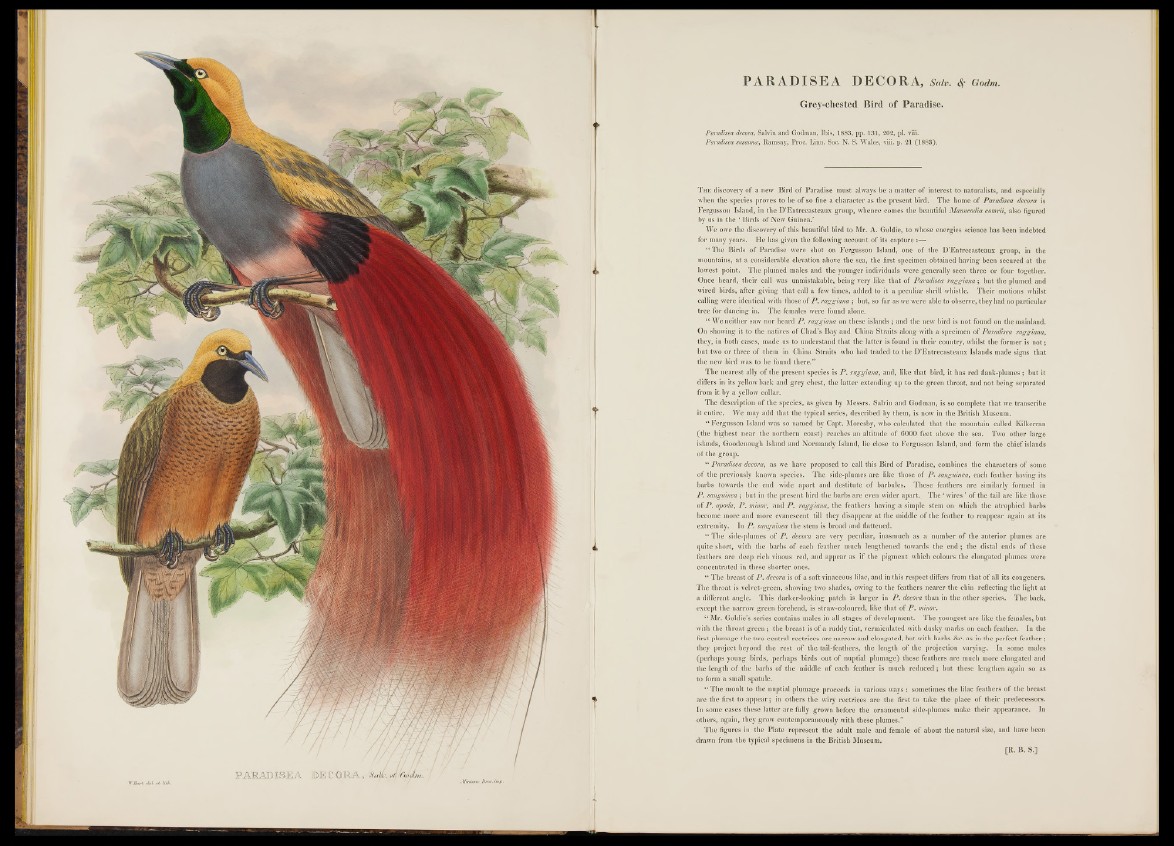
PARADISEA DECORA, Safo. $ Godm.
Grey-chested Bird of Paradise.
Paradisea decora, Salvin and Godman, Ibis, 1883, pp. 131, 202, pi. viii.
Paradisea susamee, Ramsay, Proc. Lino. Soc. N. S. Wales, viii. p. 21 (1 883).
T h e discovery of a new Bird o f Paradise must always be a matter o f interest to naturalists, and especially
when the species proves to be o f so fine a character as the present bird. The home of Paradisea decora is
Fergusson Island, in the D ’Entrecasteaux group, whence comes the beautiful Manucodia comrii, also figured
by us in the ‘ Birds of New Guinea.’
We owe the discovery o f this beautiful bird to Mr. A. Goldie, to whose energies science has been indebted
for many years. He has given the following account o f its capture
“ The Birds o f Paradise were shot on Fergusson Island, one o f the D’Entrecasteaux group, in the
mountains, at a considerable elevation above the sea, the first specimen obtained having been secured at the
lowest point. The plumed males and the younger individuals were generally seen three or four together.
Once heard, their call was unmistakable, being very like that of Paradisea raggiana; but the plumed and
wired birds, after giving that call a few times, added to it a peculiar shrill whistle. Their motions whilst
calling were identical with those o f P . raggiana ; but, so far as we were able to observe, they had no particular
tree for dancing in. The females were found alone.
“ We neither saw nor heard P . raggiana on these islands ; and the new bird is not found on the mainland.
On showing it to the natives o f Chad’s Bay and China Straits along with a specimen o f Paradisea raggiana,
they, in both cases, made us to understand that the latter is found in their country, whilst the former is not;
but two or three of them in China Straits who had traded to the D ’Entrecasteaux Islands made signs that
the new bird was to be found there.”
The nearest ally o f the present species is P . raggiana, and, like that bird, it has red flank-plumes ; but it
differs in its yellow back and grey chest, the latter extending up to the green throat, and not being separated
from it by a yellow collar.
The description o f the species, as given by Messrs. Salvin and Godman, is so complete that we transcribe
it entire. We may add that the typical series, described by them, is now in the British Museum.
“ Fergusson Island was so named by Capt. Moresby, who calculated that the mountain called Kilkerran
(the highest near the northern coast) reaches an altitude of 6000 feet above the sea. Two other large
islands, Goodenough Island and Normandy Island, lie close to Fergusson Island, and form the chief islands
of the group.
“ Paradisea decora, as we have proposed to call this Bird o f Paradise, combines the characters o f some
of the previously known species. The side-plumes are like those o f P . sanguinea, each feather having its
barbs towards the end wide apart and destitute o f barbules. These feathers are similarly formed in
P . sanguinea ; but in the present bird the barbs are even wider apart. The ‘ wires ’ o f the tail are like those
o f P . apoda, P . minor, and P . raggiana, the feathers having a simple stem on which the atrophied barbs
become more and more evanescent till they disappear at the middle of the feather to reappear again at its
extremity. In P . sanguinea the stem is broad and flattened.
“ The side-plumes o f P . decora are very peculiar, inasmuch as a number o f the.anterior plumes are
quite short, with the barbs o f each feather much lengthened towards the en d ; the distal ends of these
feathers are deep rich vinous red, and appear as if the pigment which colours the elongated plumes were
concentrated in these shorter ones.
“ The breast o f P . decora is o f a soft vinaceous lilac, and in this respect differs from that o f all its congeners.
The throat is velvet-green, showing two shades, owing to the feathers nearer the chin reflecting the light at
a different angle. This darker-looking patch is larger in P . decora than in the other species. The back,
except the narrow green forehead, is straw-coloured, like that o f P . minor.
“ Mr. Goldie’s series contains males in all stages o f development. The youngest are like the females, but
with the throat green ; the breast is o f a ruddy tint, vermiculated with dusky marks on each feather. In the
first plumage the two central rectrices are narrow and elongated, but with barbs &c. as in the perfect feather;
they project beyond the rest o f the tail-feathers, the length o f the projection varying. In some males
(perhaps young birds, perhaps birds out of nuptial plumage) these feathers are much more elongated and
the length o f the barbs o f the middle o f each feather is much reduced; but these lengthen again so as
to form a small spatule.
“ The moult to the nuptial plumage proceeds in various ways : sometimes the lilac feathers of the breast
are the first to appear; in others the wiry rectrices are the first to take the place of their predecessors.
In some cases these latter are fully grown before the ornamental side-plumes make their appearance. In
others, again, they grow contemporaneously with these plumes.”
The figures in the Plate represent the adult male and female o f about the natural size, and have been
drawn from the typical specimens in the British Museum.
[R. B. S.]